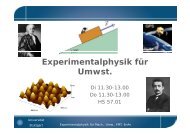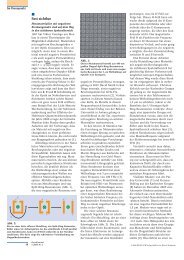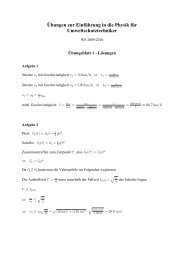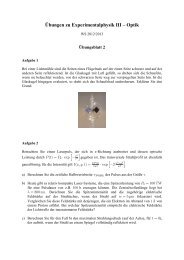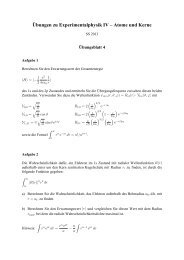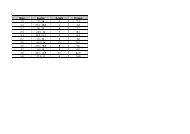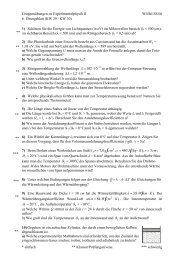Near-field–induced tunability of surface plasmon polaritons in ...
Near-field–induced tunability of surface plasmon polaritons in ...
Near-field–induced tunability of surface plasmon polaritons in ...
You also want an ePaper? Increase the reach of your titles
YUMPU automatically turns print PDFs into web optimized ePapers that Google loves.
Journal <strong>of</strong> Microscopy, Vol. 229, Pt 2 2008, pp. 344–353<br />
Received 13 November 2006; accepted 8 May 2007<br />
<strong>Near</strong>-<strong>field–<strong>in</strong>duced</strong> <strong>tunability</strong> <strong>of</strong> <strong>surface</strong> <strong>plasmon</strong> <strong>polaritons</strong><br />
<strong>in</strong> composite metallic nanostructures<br />
A. CHRIST∗ , G. LÉVÊQUE∗ , O. J. F. MARTIN∗ ,<br />
T. ZENTGRAF†, J. KUHL†, C. BAUER‡, H. GIESSEN‡<br />
& S. G. TIKHODEEV§<br />
∗Nanophotonics and Metrology Laboratory, Swiss Federal Institute <strong>of</strong> Technology Lausanne,<br />
EPFL-STI-NAM, ELG Station 11, CH-1015 Lausanne, Switzerland<br />
†Max Planck Institute for Solid State Research, 70569 Stuttgart, Germany<br />
‡4th Physics Institute, University <strong>of</strong> Stuttgart, 70550 Stuttgart, Germany<br />
§A. M. Prokhorov General Physics Institute RAS, 119991 Moscow, Russia<br />
Key words. Interaction, magnetic activity, near-fields, <strong>surface</strong> <strong>plasmon</strong><br />
<strong>polaritons</strong>.<br />
Summary<br />
We numerically study near-<strong>field–<strong>in</strong>duced</strong> coupl<strong>in</strong>g effects<br />
<strong>in</strong> metal nanowire-based composite nanostructures. Our<br />
multi-layer system is composed <strong>of</strong> <strong>in</strong>dividual gold nanowires<br />
support<strong>in</strong>g localized particle <strong>plasmon</strong>s at optical wavelengths,<br />
and a spatially separated homogeneous silver slab support<strong>in</strong>g<br />
delocalized <strong>surface</strong> <strong>plasmon</strong>s. We show that the localized<br />
<strong>plasmon</strong> modes <strong>of</strong> the composite structure, form<strong>in</strong>g so-called<br />
magnetic atoms, can be controlled over a large spectral<br />
range by chang<strong>in</strong>g the thickness <strong>of</strong> the nearby metal slab.<br />
The optical response <strong>of</strong> s<strong>in</strong>gle-wire and array-based metallic<br />
structures are compared. Spectral shifts due to wire–mirror<br />
<strong>in</strong>teraction as well as the coupl<strong>in</strong>g between localized and<br />
delocalized <strong>surface</strong> <strong>plasmon</strong> modes <strong>in</strong> a magnetic photonic<br />
crystal are demonstrated. The presented effects are important<br />
for the optimization <strong>of</strong> metal-based nanodevices and may<br />
lead to the realization <strong>of</strong> metamaterials with novel <strong>plasmon</strong>ic<br />
functionalities.<br />
Introduction<br />
Metal structures support<strong>in</strong>g <strong>surface</strong> <strong>plasmon</strong> polariton modes<br />
play a crucial role <strong>in</strong> several emerg<strong>in</strong>g fields <strong>of</strong> nanoscience,<br />
where their remarkable optical properties are currently the<br />
subject <strong>of</strong> considerable research efforts. In particular, metal<br />
nanoparticles support<strong>in</strong>g localized <strong>surface</strong> <strong>plasmon</strong> polariton<br />
modes (i.e. so-called particle <strong>plasmon</strong>s) are characterized<br />
by a significant enhancement <strong>of</strong> their local electromagnetic<br />
fields (Kottmann et al., 2001a, and references there<strong>in</strong>). The<br />
Correspondence to: A. Christ. Tel: +41 21 693 3968; fax: +41 21 593 2614; e-mail:<br />
andre.christ@epfl.ch<br />
achievable high field <strong>in</strong>tensities are a direct consequence <strong>of</strong><br />
the excitation <strong>of</strong> collective electron charge density oscillations<br />
<strong>in</strong> the metal particles. Such <strong>plasmon</strong>ic resonances allow<br />
for conf<strong>in</strong><strong>in</strong>g light on the nanoscale and can be applied<br />
to alter light–matter <strong>in</strong>teractions. Plasmon functionalities<br />
are used for the enhancement <strong>of</strong> Raman scatter<strong>in</strong>g signals<br />
on <strong>surface</strong>s (Moskovits, 1985), for the design <strong>of</strong> chemical<br />
and biological sensors (Homola et al., 1999), and for the<br />
realization <strong>of</strong> novel resonant magnetic nanostructures (L<strong>in</strong>den<br />
et al., 2004; Rockstuhl et al., 2006). In addition to s<strong>in</strong>gleparticle<br />
phenomena, <strong>in</strong>teract<strong>in</strong>g particle ensembles also<br />
exhibit <strong>in</strong>terest<strong>in</strong>g optical effects (Rechenberger et al., 2003;<br />
Maier, 2002). A very impressive example is the use <strong>of</strong><br />
coupled metal nanoparticles to design nanometer-scale dipole<br />
antennas. It has been demonstrated recently that direct optical<br />
excitation results <strong>in</strong> white-light supercont<strong>in</strong>uum generation<br />
due to the achievable strong field enhancement with<strong>in</strong> the<br />
feed-gap <strong>of</strong> the nanoantenna (Mühlschlegel et al., 2005).<br />
Generally, all <strong>surface</strong> <strong>plasmon</strong> polariton-related phenomena<br />
such as supercont<strong>in</strong>uum generation are resonant effects<br />
and very sensitive to the chosen light frequency. Therefore,<br />
the nanoantenna design has to fulfill two fundamental<br />
requirements. First, the particle geometry and the supported<br />
collective <strong>surface</strong> <strong>plasmon</strong> <strong>polaritons</strong> should allow for a<br />
reasonably strong field enhancement. Second, the <strong>plasmon</strong><br />
mode should be tunable by simple geometrical modifications<br />
<strong>of</strong> the structure to br<strong>in</strong>g it <strong>in</strong> resonance with the chosen<br />
excitation frequency. In addition to the use <strong>of</strong> s<strong>in</strong>gle particlebased<br />
antenna structures, coupled particles support<strong>in</strong>g dimer<br />
<strong>plasmon</strong> modes appear very promis<strong>in</strong>g (Kottmann & Mart<strong>in</strong>,<br />
2001; Nordlander et al., 2004). The optical properties <strong>of</strong> such<br />
dimer structures are not only controlled by the particle size,<br />
C○ 2008 The Authors<br />
Journal compilation C○ 2008 The Royal Microscopical Society
they are also strongly <strong>in</strong>fluenced by the spatial separation <strong>of</strong><br />
the <strong>in</strong>dividual metal scatterers (i.e. the width <strong>of</strong> the antenna<br />
feed gap).<br />
In this paper we study an alternative approach for the<br />
possible realization <strong>of</strong> <strong>surface</strong> <strong>plasmon</strong> <strong>tunability</strong>. If a metal<br />
particle, that is a resonant optical dipole nanoantenna, is<br />
placed close to a reflect<strong>in</strong>g metal <strong>in</strong>terface, its <strong>plasmon</strong>ic<br />
properties are strongly modified. In addition to the <strong>in</strong>teraction<br />
between the <strong>in</strong>dividual particle and its own image (Nordlander<br />
& Prodan, 2004; Lévêque, 2006), the coupl<strong>in</strong>g to delocalized<br />
<strong>surface</strong> <strong>plasmon</strong> modes on the <strong>in</strong>terface can play a significant<br />
role <strong>in</strong> the response <strong>of</strong> the system (Cesario et al., 2005; Christ<br />
et al., 2006). In particular, we show hat the optical response<br />
<strong>of</strong> such a composite structure depends on the thickness <strong>of</strong><br />
the underly<strong>in</strong>g metal slab. For the sake <strong>of</strong> completeness, our<br />
theoretical work addresses isolated wires as well as periodic<br />
nanowire arrays.<br />
Additionally, the important magnetic properties <strong>of</strong> the<br />
composite structure are briefly discussed. Similar to cut-wire<br />
pairs (Doll<strong>in</strong>g et al., 2005), the supported localized <strong>plasmon</strong><br />
modes <strong>of</strong> the composite structure can be <strong>in</strong>terpreted <strong>in</strong> terms<br />
<strong>of</strong> so-called magnetic atoms. Especially, a periodic arrangement<br />
<strong>of</strong> these artificial atoms might be <strong>of</strong> certa<strong>in</strong> <strong>in</strong>terest. However,<br />
although the metamaterial limit is not valid s<strong>in</strong>ce the elements<br />
have dimensions comparable to the wavelength, the magnetic<br />
atoms can be arranged to form what is known as magnetic<br />
photonic crystal (L<strong>in</strong>den et al., 2006).<br />
Model system and theoretical description<br />
The analyzed composite nanostructures are sketched <strong>in</strong> panels<br />
(a) and (b) <strong>of</strong> Fig. 1. We consider a two-dimensional nanowirebased<br />
geometry. The <strong>in</strong>variant direction is the y-axis, the plane<br />
parallel to the silver film is (Oxy), and the z-axis is oriented<br />
normal to the silver <strong>in</strong>terface. Each s<strong>in</strong>gle gold nanowire is<br />
15 nm thick and 100 nm wide. It is embedded <strong>in</strong> a fused<br />
silica environment <strong>of</strong> <strong>in</strong>dex n = 1.46, and is separated from<br />
a silver film <strong>of</strong> thickness Lfilm by a spacer with thickness Lsp.<br />
The medium below the film (substrate) is fused silica as well.<br />
In the case <strong>of</strong> a nanowire grat<strong>in</strong>g, the period is specified by dx.<br />
The <strong>in</strong>cident field is a plane wave that propagates along the<br />
z-direction. The polarization plane is (Oxz) correspond<strong>in</strong>g to<br />
transverse magnetic (TM) polarization, that is the magnetic<br />
field component <strong>of</strong> the <strong>in</strong>cident wave is oriented parallel to the<br />
metal nanowires.<br />
All calculations for the s<strong>in</strong>gle-wire case are performed with<br />
the dyadic Green’s tensor method, based on the solution <strong>of</strong> the<br />
Lippmann–Schw<strong>in</strong>ger equation for the electric field (Mart<strong>in</strong><br />
& Piller, 1998; Paulus et al., 2000; Lévêque et al., 2004). This<br />
method is well suited for the study <strong>of</strong> localized objects embedded<br />
<strong>in</strong> a dielectric and/or metallic multi-layered medium, both<br />
for 2D and 3D geometries. Furthermore, a scatter<strong>in</strong>g-matrix<br />
based formalism has been employed for calculat<strong>in</strong>g the optical<br />
response<strong>of</strong>theperiodicstructure(Tikhodeevetal.,2002).Both<br />
C○ 2008 The Authors<br />
Journal compilation C○ 2008 The Royal Microscopical Society, Journal <strong>of</strong> Microscopy, 229, 344–353<br />
TUNABILITY OF SURFACE PLASMON POLARITONS 345<br />
Fig. 1. Schematic view <strong>of</strong> the two composite metal nanostructures studied<br />
<strong>in</strong> this paper. The structure <strong>in</strong> panel (a) consits <strong>of</strong> a s<strong>in</strong>gle gold nanowire<br />
positioned <strong>in</strong> front <strong>of</strong> a th<strong>in</strong> silver slab. The thickness <strong>of</strong> the metal film<br />
Lfilm as well as the wire–slab separation Lsp has strong <strong>in</strong>fluence on the<br />
detected optical response <strong>of</strong> the system. The other system is shown <strong>in</strong><br />
panel (b). Instead <strong>of</strong> a s<strong>in</strong>gle wire, a periodic nanowire array is considered<br />
as the second layer <strong>of</strong> the composite structure. All studies <strong>in</strong> this paper<br />
are restricted to TM polarization (magnetic field oriented parallel to the<br />
nanowires).<br />
methods work without any adjustable fit parameters, and only<br />
the geometrical properties and the dielectric susceptibilities<br />
<strong>of</strong> the constituent materials are taken <strong>in</strong>to account as <strong>in</strong>put<br />
parameters. Throughout the paper, we use the data <strong>of</strong> Johnson<br />
and Christy for the permittivity <strong>of</strong> gold and silver (Johnson &<br />
Christy, 1972).<br />
S<strong>in</strong>gle wire case<br />
We start with the <strong>in</strong>vestigation <strong>of</strong> the s<strong>in</strong>gle wire case to<br />
highlight the modifications <strong>of</strong> the optical properties <strong>in</strong>duced by<br />
the metal film. It has already been shown <strong>in</strong> Christ et al. (2006)<br />
and Lévêque & Mart<strong>in</strong> (2006) that the localized <strong>plasmon</strong><br />
resonance <strong>of</strong> a metal particle is strongly redshifted when an<br />
additional metal film is placed <strong>in</strong> close proximity. However,<br />
the fundamental <strong>in</strong>fluence <strong>of</strong> the metal slab thickness has not<br />
yet been <strong>in</strong>vestigated. Figure 2 thus displays the numerically<br />
obta<strong>in</strong>ed <strong>in</strong>tensity <strong>of</strong> the electric field scattered by a s<strong>in</strong>gle<br />
gold nanowire <strong>in</strong> dependence <strong>of</strong> the thickness <strong>of</strong> the silver<br />
slab. The displayed <strong>in</strong>tensities correspond to the field scattered<br />
<strong>in</strong> the <strong>in</strong>cidence medium. In the s<strong>in</strong>gle-particle spectroscopic<br />
studies, the scattered field is computed <strong>in</strong> the far field, <strong>in</strong> the<br />
direction perpendicular to the <strong>in</strong>terface. The slab thickness is<br />
<strong>in</strong>creased from 20 to 50 nm <strong>in</strong> steps <strong>of</strong> 5 nm. Additionally,<br />
the scattered spectrum <strong>of</strong> a bare nanowire without the<br />
nearby silver film is shown as a reference <strong>in</strong> both panels.
346 A. CHRIST ET AL.<br />
Fig. 2. Intensity <strong>of</strong> the electric field scattered by an isolated gold nanowire (dotted red l<strong>in</strong>es) and by a gold nanowire placed <strong>in</strong> front <strong>of</strong> a silver slab (solid<br />
black l<strong>in</strong>es) as a function <strong>of</strong> the photon energy. Results for structures with wire–film separation <strong>of</strong> Lsp = 20 nm (a) and Lsp = 50 nm (b) are compared for<br />
TM polarization. From bottom to top, the slab thickness is <strong>in</strong>creased from Lfilm = 20 nm to Lfilm = 50 <strong>in</strong> steps <strong>of</strong> 5 nm. For clarity, the <strong>in</strong>dividual spectra<br />
are each shifted upwards by 1 unit.<br />
Wire–film separations <strong>of</strong> Lsp = 20 nm, Fig. 2a, and Lsp = 50 nm,<br />
Fig. 2b, are considered. The spectra <strong>in</strong> Fig. 2 reveal two<br />
important phenomena. First, the localized <strong>surface</strong> <strong>plasmon</strong><br />
mode <strong>of</strong> the wire is redshifted from its orig<strong>in</strong>al position at<br />
1.67 eV due to wire–mirror <strong>in</strong>teraction. The l<strong>in</strong>ear restor<strong>in</strong>g<br />
forces <strong>of</strong> the collectively displaced nanowire conduction band<br />
electrons are effectively reduced due to near-field coupl<strong>in</strong>g with<br />
the <strong>in</strong>duced image dipole (which has the opposite orientation).<br />
As expected and previously shown, the observed redshift is<br />
stronger for smaller spacer thicknesses (Lévêque, 2005). The<br />
<strong>plasmon</strong> related <strong>in</strong>tensity maximum is shifted to 1.28 eV <strong>in</strong><br />
Fig. 2a and 1.43 eV <strong>in</strong> Fig. 2b, respectively. Second, the near<strong>field–<strong>in</strong>duced</strong><br />
redshift reveals no dependence on the thickness<br />
<strong>of</strong> the nearby silver film. Both panels <strong>of</strong> Fig. 2 <strong>in</strong>dicate that<br />
the observed redshift is only weakly modified when the slab<br />
thickness is varied from 20 to 50 nm. This <strong>in</strong>terest<strong>in</strong>g fact is<br />
directly related to the small sk<strong>in</strong> depth <strong>of</strong> the considered silver<br />
film (∼20 nm); the electromagnetic waves are strongly damped<br />
with<strong>in</strong> the first few nanometers <strong>of</strong> the metal slab. As a result,<br />
the observed mirror coupl<strong>in</strong>g effect is only weakly modified<br />
when the film thickness exceeds the sk<strong>in</strong> depth. By contrast,<br />
the achievable scatter<strong>in</strong>g <strong>in</strong>tensities are strongly <strong>in</strong>fluenced by<br />
the thickness <strong>of</strong> the metal slab. The <strong>in</strong>tensity <strong>of</strong> the scattered<br />
electric field is enhanced with Lfilm, because the silver film<br />
reflectivity <strong>in</strong>creases.<br />
Additional <strong>in</strong>formation is obta<strong>in</strong>ed from the calculated<br />
spatial field distributions. Electric (a,c) and magnetic (b,d) field<br />
amplitudes <strong>in</strong> a plane perpendicular to the nanowires are<br />
plotted <strong>in</strong> Fig. 3. An isolated wire and a wire <strong>in</strong> <strong>in</strong>teraction with<br />
the film, assum<strong>in</strong>g a 20-nm-thick silver slab and a 20-nmthick<br />
spacer, are compared. The electric and magnetic fields<br />
are shown at the localized <strong>plasmon</strong> resonance frequencies <strong>of</strong><br />
1.67 eV (isolated wire) and 1.24 eV (wire–film), respectively.<br />
All fields are normalized to the amplitude <strong>of</strong> the <strong>in</strong>cident plane<br />
wave. Note that the magnetic field is not displayed <strong>in</strong>side the<br />
gold nanowires ow<strong>in</strong>g to limitations <strong>of</strong> the numerical method.<br />
Indeed, <strong>in</strong> the version <strong>of</strong> the Green’s tensor method used for<br />
these calculations, the magnetic field is computed by tak<strong>in</strong>g<br />
the numerical rotational <strong>of</strong> the electric field. This is possible<br />
only outside the object, where the computation step can be<br />
arbitrary. On the contrary, the computation step is constant<br />
<strong>in</strong>side the object, and too large for a precise evaluation <strong>of</strong> the<br />
magnetic field.<br />
The field distribution <strong>of</strong> the localized <strong>plasmon</strong> mode <strong>in</strong><br />
the wire–film geometry is characterized by a dist<strong>in</strong>ct spatial<br />
shape. As schematically <strong>in</strong>dicated <strong>in</strong> panel (e) <strong>of</strong> Fig. 3, the<br />
related localized resonance can be <strong>in</strong>terpreted <strong>in</strong> terms <strong>of</strong><br />
so-called magnetic atoms. Other prom<strong>in</strong>ent realizations are<br />
the well-known split-r<strong>in</strong>g resonators (L<strong>in</strong>den et al., 2004)<br />
or the closely related cut-wire pairs (Doll<strong>in</strong>g et al., 2005)<br />
which have been used as elementary build<strong>in</strong>g blocks <strong>in</strong> recent<br />
metamaterial design (Doll<strong>in</strong>g et al., 2006). In particular, the<br />
wire–film geometry directly mimics the magnetic, that is the<br />
anti-symmetric, dimer <strong>plasmon</strong> mode <strong>of</strong> a stacked wire pair. A<br />
very simple <strong>in</strong>terpretation is that based on <strong>in</strong>ductor–capacitor<br />
(LC) circuits (Meyrath et al., 2006, Unpublished data). The<br />
C○ 2008 The Authors<br />
Journal compilation C○ 2008 The Royal Microscopical Society, Journal <strong>of</strong> Microscopy, 229, 344–353
TUNABILITY OF SURFACE PLASMON POLARITONS 347<br />
Fig. 3. Distribution <strong>of</strong> the electric and magnetic field amplitudes for an isolated gold nanowire (a, b) and for a s<strong>in</strong>gle gold nanowire <strong>in</strong> front <strong>of</strong> a 20-nm-thick<br />
silver film (c, d). The fields are shown for energies <strong>of</strong> 1.67 and 1.24 eV <strong>in</strong> a plane perpendicular to the nanowires. A wire–film separation <strong>of</strong> Lsp = 20 nm is<br />
chosen <strong>in</strong> panels (c) and (d). The electric and magnetic fields are normalized to their <strong>in</strong>cident amplitude, respectively. White l<strong>in</strong>es denote the cross-section<br />
<strong>of</strong> the gold wires and the silver film. Ow<strong>in</strong>g to the numerical method, magnetic fields are not displayed <strong>in</strong>side the gold nanowire. Panel (e) illustrates<br />
possible realizations <strong>of</strong> <strong>plasmon</strong>ic resonator geometries: split-r<strong>in</strong>g resonator, wire-pair, and wire-mirror structure.<br />
specific nature <strong>of</strong> the localized resonance can be directly<br />
deduced from the field distributions <strong>in</strong> panels (c) and (d) <strong>of</strong><br />
Fig. 3, which <strong>in</strong>dicate that the resonance results from the antisymmetric<br />
coupl<strong>in</strong>g <strong>of</strong> the particle dipole with its image created<br />
by the silver layer. This produces a two-lobed structure with<br />
high electric fields between the wire edges and the metal slab,<br />
<strong>in</strong>dicat<strong>in</strong>g the strong displacement currents. The magnetic<br />
field <strong>in</strong> Fig. 3d is ma<strong>in</strong>ly concentrated <strong>in</strong> the spacer below<br />
the wire as a result <strong>of</strong> the <strong>in</strong>duced circular currents. In<br />
particular, when the particle is approach<strong>in</strong>g the film, most<br />
<strong>of</strong> the electromagnetic energy is concentrated between the<br />
gold particle and the silver film. It has been demonstrated<br />
<strong>in</strong> several studies that the enhancement factor <strong>of</strong> the electric<br />
C○ 2008 The Authors<br />
Journal compilation C○ 2008 The Royal Microscopical Society, Journal <strong>of</strong> Microscopy, 229, 344–353<br />
field between two sharp metallic systems <strong>in</strong>creases for small<br />
distances. For example, assum<strong>in</strong>g Lsp = 20 nm as depicted <strong>in</strong><br />
panel (c), the enhancement factor <strong>of</strong> the electric field <strong>in</strong>tensity<br />
(at the center between the wire corner and the slab) is about<br />
160 times the <strong>in</strong>cident electric field <strong>in</strong>tensity. The associated<br />
enhancement factor <strong>of</strong> the magnetic-field <strong>in</strong>tensity is around<br />
40 (between the wire and the slab), which is smaller than<br />
that associated with the electric field. Without the silver film,<br />
as shown <strong>in</strong> panels (a) and (b), the electric field is ma<strong>in</strong>ly<br />
concentrated at the corners <strong>of</strong> the particle. The magnetic field<br />
is ma<strong>in</strong>ly concentrated on the top <strong>of</strong> the gold particle, where<br />
the <strong>in</strong>cident field constructively <strong>in</strong>terferes with the reflected<br />
field.
348 A. CHRIST ET AL.<br />
Fig. 4. Calculated reflection, transmission, and absorption spectra for two different <strong>surface</strong> <strong>plasmon</strong> polaritonic crystals (solid black l<strong>in</strong>es). The gold<br />
grat<strong>in</strong>gs with a period <strong>of</strong> dx = 500 nm are placed <strong>in</strong> front <strong>of</strong> a 20-nm-thick silver slab. Structures with a grat<strong>in</strong>g–film separation <strong>of</strong> Lsp = 20 nm (a–c)<br />
and Lsp = 50 nm (d–f) are considered. The spectra are shown for normal light <strong>in</strong>cidence and TM polarization. Additionally, the spectra <strong>of</strong> a bare grat<strong>in</strong>g<br />
(dashed blue l<strong>in</strong>es) and <strong>of</strong> a bare silver slab (dotted red l<strong>in</strong>es) are shown as reference.<br />
Composite <strong>surface</strong> <strong>plasmon</strong> polaritonic crystal<br />
In our next step, we extend the numerical study to composite<br />
structures based on periodic nanowire arrays. Therefore the<br />
optical properties <strong>of</strong> so-called <strong>surface</strong> <strong>plasmon</strong> polaritonic<br />
crystals (see Fig. 1b) are carefully analyzed to clarify the<br />
<strong>in</strong>duced spectral changes. In contrast to the discussed s<strong>in</strong>gle<br />
nanowire case, the periodic design now <strong>of</strong>fers an additional<br />
degree <strong>of</strong> freedom. The supported Bloch modes, that is<br />
the delocalized <strong>surface</strong> <strong>plasmon</strong>s <strong>of</strong> the slab, can be tuned<br />
<strong>in</strong> resonance with the localized mode by chang<strong>in</strong>g the<br />
geometrical parameters <strong>of</strong> the structure. The slab thickness<br />
as well as the nanowire period have to be controlled to adjust<br />
the optical response <strong>of</strong> the nanostructure.<br />
The nanowire array related modifications are highlighted <strong>in</strong><br />
Fig. 4 for composite structures with spacer thicknesses Lsp =<br />
20 nm (a–c) and Lsp = 50 nm (d–f). The gold nanowire<br />
arrays with a period <strong>of</strong> dx = 500 nm are placed <strong>in</strong> front<br />
<strong>of</strong> a 20-nm-thick silver film. The large period is chosen to<br />
prevent direct near-field coupl<strong>in</strong>g between the <strong>in</strong>dividual gold<br />
wires <strong>of</strong> the lattice, which generally results <strong>in</strong> a redshift<br />
<strong>of</strong> the localized <strong>plasmon</strong> mode (Rechenberger et al., 2003).<br />
Reflection, transmission and absorption spectra are plotted<br />
for TM polarization and normal <strong>in</strong>cidence. Figure 4 also<br />
<strong>in</strong>cludes the numerical spectra <strong>of</strong> two reference structures.<br />
First, the spectra <strong>of</strong> the bare grat<strong>in</strong>g without metal film<br />
are shown (dashed blue l<strong>in</strong>e). Second, the spectra <strong>of</strong> an<br />
unstructured 20-nm-thick silver film are <strong>in</strong>cluded (dotted red<br />
l<strong>in</strong>es). Generally, two types <strong>of</strong> <strong>surface</strong> <strong>plasmon</strong> polariton modes<br />
should be supported by the nanowire-array–based composite<br />
structure. In addition to localized wire <strong>plasmon</strong> modes, the<br />
Bragg-periodic nature should allow for efficient excitation <strong>of</strong><br />
delocalized <strong>surface</strong> <strong>plasmon</strong> modes at the nearby silver film.<br />
If the metal grat<strong>in</strong>g is considered as a weak perturbation,<br />
the silver slab is characterized by a symmetric surround<strong>in</strong>g<br />
(i.e. the metal slab is coated by silica on both sides). As a<br />
result, the <strong>surface</strong> <strong>plasmon</strong> modes at both <strong>in</strong>terfaces <strong>of</strong> the<br />
th<strong>in</strong> film couple. The degeneracy is lifted, and short- and longrange<br />
modes are formed (Burke et al., 1986). It should be<br />
mentioned that the s<strong>in</strong>gle wire geometry also generally allows<br />
for excitation <strong>of</strong> delocalized <strong>surface</strong> <strong>plasmon</strong> modes (Ditlbacher<br />
et al., 2002). However, <strong>in</strong> comparison to the localized <strong>plasmon</strong><br />
mode, the excitation efficiency <strong>of</strong> delocalized modes is much<br />
weaker.<br />
As a matter <strong>of</strong> fact, the spectra <strong>in</strong> Figs 4a–c give direct<br />
evidence for the excitation <strong>of</strong> various <strong>surface</strong> <strong>plasmon</strong><br />
modes. Instead <strong>of</strong> a s<strong>in</strong>gle spectral feature (e.g. see Fig. 2),<br />
three pronounced resonances can be observed. The three<br />
pronounced absorption maxima are related to reflection<br />
m<strong>in</strong>ima and dispersive (Fano-like) features <strong>in</strong> the transmission<br />
spectra. Two spectrally broad modes are accompanied by<br />
a s<strong>in</strong>gle narrow l<strong>in</strong>e. The reference spectra by contrast<br />
show no surpris<strong>in</strong>g results. For example, the spectra <strong>of</strong> the<br />
silver films (dotted red l<strong>in</strong>es <strong>in</strong> Fig. 4) are more or less<br />
C○ 2008 The Authors<br />
Journal compilation C○ 2008 The Royal Microscopical Society, Journal <strong>of</strong> Microscopy, 229, 344–353
structureless whereas the localized wire <strong>plasmon</strong> <strong>of</strong> the<br />
bare grat<strong>in</strong>g can be directly observed (dashed blue l<strong>in</strong>es <strong>in</strong><br />
Fig. 4).<br />
The nature <strong>of</strong> the different resonances observed <strong>in</strong> Fig. 4 can<br />
be easily deduced from the correspond<strong>in</strong>g field distributions.<br />
The numerically obta<strong>in</strong>ed spatial distributions <strong>of</strong> the electric<br />
and magnetic fields are therefore displayed <strong>in</strong> Fig. 5 for normal<br />
TUNABILITY OF SURFACE PLASMON POLARITONS 349<br />
light <strong>in</strong>cidence and TM polarization. Shown are the normalized<br />
time-averaged field amplitudes for a nanowire structure with a<br />
period <strong>of</strong> dx = 500 nm, an array–film separation <strong>of</strong> Lsp = 20 nm,<br />
and a 20-nm-thick silver film. The local fields are plotted for<br />
<strong>in</strong>com<strong>in</strong>g photon energies <strong>of</strong> 1.245, 1.553 and 1.685 eV. The<br />
chosen photon energies correspond to the spectral positions <strong>of</strong><br />
the absorption maxima <strong>in</strong> Fig. 4c.<br />
Fig. 5. Calculated spatial field distributions <strong>of</strong> the electric and magnetic fields for normal light <strong>in</strong>cidence and TM polarization. Shown are the normalized<br />
time-averaged field amplitudes for a nanowire structure with a periodicity <strong>of</strong> dx = 500 nm, a grat<strong>in</strong>g–film separation <strong>of</strong> Lsp = 20 nm and a 20-nm-thick<br />
silver slab. The local fields are depicted for an <strong>in</strong>com<strong>in</strong>g photon energy <strong>of</strong> h − ω = 1.245 eV (a, b), h − ω = 1.553 eV (c, d) and h − ω = 1.685 eV (e, f) <strong>in</strong> a<br />
plane perpendicular to the nanowires. The chosen energies correspond to the positions <strong>of</strong> the absorption maxima <strong>in</strong> Fig. 4c. The field distributions are<br />
normalized to the maximum electric or magnetic field (value is <strong>in</strong>dicated <strong>in</strong> each panel) measured <strong>in</strong> units <strong>of</strong> the <strong>in</strong>com<strong>in</strong>g field with amplitudes equal to<br />
one. White l<strong>in</strong>es <strong>in</strong>dicate the cross-section <strong>of</strong> the gold wires and the silver film.<br />
C○ 2008 The Authors<br />
Journal compilation C○ 2008 The Royal Microscopical Society, Journal <strong>of</strong> Microscopy, 229, 344–353
350 A. CHRIST ET AL.<br />
The first maximum at 1.245 eV can be directly attributed<br />
to the excitation <strong>of</strong> a localized <strong>plasmon</strong> mode. Its energy<br />
approximately fits the spectral position <strong>of</strong> the <strong>surface</strong><br />
<strong>plasmon</strong> mode <strong>of</strong> the s<strong>in</strong>gle wire-based composite structure <strong>in</strong><br />
Fig. 2a. Furthermore, the correspond<strong>in</strong>g fields show the<br />
identical characteristic spatial distribution already discussed<br />
for the s<strong>in</strong>gle wire case <strong>in</strong> Figs 3c and d. Strong electric fields<br />
are found at both edges <strong>of</strong> the gold nanowires. The magnetic<br />
field by contrast is concentrated directly below the wires,<br />
that is with<strong>in</strong> the 20-nm-thick spacer. Similar to the s<strong>in</strong>gle<br />
wire case, the <strong>in</strong>dividual nanowires <strong>of</strong> the ensemble act as<br />
small dipole antennas and <strong>in</strong>duce image dipoles with<strong>in</strong> the<br />
metal film. <strong>Near</strong>-field coupl<strong>in</strong>g leads to a modification <strong>of</strong> the<br />
effective l<strong>in</strong>ear restor<strong>in</strong>g forces that arise due to the collectively<br />
displaced nanowire conduction band electrons. As a result,<br />
the supported localized <strong>plasmon</strong> mode is strongly redshifted <strong>in</strong><br />
comparison to the sole resonance <strong>of</strong> the bare grat<strong>in</strong>g (dashed<br />
l<strong>in</strong>es <strong>in</strong> Fig. 4). Note that the periodic arrangement <strong>of</strong> <strong>in</strong>dividual<br />
magnetic atoms can be <strong>in</strong>terpreted <strong>in</strong> terms <strong>of</strong> a so-called<br />
one-dimensional magnetic photonic crystal (L<strong>in</strong>den et al.,<br />
2006).<br />
The character <strong>of</strong> the second resonance at 1.553 eV <strong>in</strong><br />
Fig. 4c differs from the localized <strong>surface</strong> <strong>plasmon</strong> mode. The<br />
correspond<strong>in</strong>g field distributions <strong>in</strong> panels (c) and (d) <strong>of</strong> Fig. 5<br />
reveal evanescent field components on both sides <strong>of</strong> the metal<br />
slab. Furthermore, the strong fields are not only localized near<br />
the <strong>in</strong>dividual wires. For example, an additional maximum<br />
<strong>of</strong> the magnetic field can be found <strong>in</strong> between two adjacent<br />
nanowires. Thus, the resonance can be undoubtedly identified<br />
as a grat<strong>in</strong>g-<strong>in</strong>duced <strong>surface</strong> <strong>plasmon</strong> mode <strong>of</strong> the metal slab.<br />
An additional grat<strong>in</strong>g-<strong>in</strong>duced <strong>surface</strong> <strong>plasmon</strong> mode can be<br />
found at 1.685 eV, that is at the spectral position <strong>of</strong> the narrow<br />
absorption l<strong>in</strong>e <strong>in</strong> Fig. 4c. The correspond<strong>in</strong>g field distributions<br />
<strong>in</strong> panels (e) and (f) <strong>of</strong> Fig. 5 show a very similar structure as<br />
the fields <strong>of</strong> the lower energy <strong>surface</strong> <strong>plasmon</strong> mode. However,<br />
the decay lengths <strong>of</strong> the evanescent electric and magnetic field<br />
components <strong>in</strong>to the ambient silica half spaces are much longer<br />
now.<br />
The correctness <strong>of</strong> the <strong>in</strong>terpretation can be further checked<br />
by analytically calculat<strong>in</strong>g the dispersion <strong>of</strong> the supported<br />
<strong>surface</strong> <strong>plasmon</strong> modes (Burke et al., 1986). In contrast to<br />
s<strong>in</strong>gle nanowire-based structures, where <strong>surface</strong> <strong>plasmon</strong>s<br />
with various propagation vectors kx can be excited at the<br />
nearby metal slab, a periodic wire arrangement restricts the<br />
possible <strong>plasmon</strong> excitation to <strong>surface</strong> modes with specific<br />
<strong>in</strong>-plane momenta. The dispersion <strong>of</strong> the short- and longrange<br />
<strong>surface</strong> <strong>plasmon</strong> modes <strong>of</strong> a 20-nm-thick silver slab<br />
(embedded <strong>in</strong> silica) are therefore shown <strong>in</strong> panel (a) <strong>of</strong> Fig. 6 <strong>in</strong><br />
empty lattice approximation. In this approximation, the mode<br />
dispersion is calculated assum<strong>in</strong>g a bare metal layer neglect<strong>in</strong>g<br />
the nearby nanowire array. The branches <strong>of</strong> the dispersion<br />
curves are then folded <strong>in</strong>to the first Brillou<strong>in</strong> zone, assum<strong>in</strong>g<br />
a periodicity <strong>of</strong> dx = 500 nm. The extracted spectral position<br />
<strong>of</strong> the long-range <strong>surface</strong> <strong>plasmon</strong> at 1.684 eV (cross<strong>in</strong>g po<strong>in</strong>t<br />
<strong>of</strong> the branches at the center <strong>of</strong> Brillou<strong>in</strong> zone) corresponds<br />
very well with the energy <strong>of</strong> the sharp absorption maximum at<br />
Fig. 6. (a) Dispersion <strong>of</strong> the short- (dashed red l<strong>in</strong>es) and long-range (solid black l<strong>in</strong>es) <strong>surface</strong> <strong>plasmon</strong> modes <strong>of</strong> a 20-nm-thick silver film <strong>in</strong> empty-lattice<br />
approximation. The modes are folded <strong>in</strong>to the first Brillou<strong>in</strong> zone assum<strong>in</strong>g a periodicity <strong>of</strong> dx = 500 nm. Additionally, the position <strong>of</strong> the localized wire<br />
<strong>plasmon</strong> (LWP) is plotted for a spacer thickness <strong>of</strong> Lsp = 20 nm. (b) Spectral position <strong>of</strong> the short- and long-range <strong>surface</strong> <strong>plasmon</strong> modes <strong>in</strong> dependence<br />
<strong>of</strong> the silver film thickness Lfilm. Periods <strong>of</strong> dx = 200 nm, dx = 300 nm, dx = 400 nm and dx = 500 nm are considered.<br />
C○ 2008 The Authors<br />
Journal compilation C○ 2008 The Royal Microscopical Society, Journal <strong>of</strong> Microscopy, 229, 344–353
1.685 eV <strong>in</strong> Fig. 4c. The large propagation length, that is the<br />
long lifetime <strong>of</strong> this <strong>surface</strong> <strong>plasmon</strong> mode, is reflected by the<br />
narrow spectral l<strong>in</strong>ewidth and the related field distribution.<br />
As already shown <strong>in</strong> panel (e) <strong>of</strong> Fig. 5, the electric field<br />
is ma<strong>in</strong>ly concentrated outside <strong>of</strong> the metal slab, <strong>in</strong>dicat<strong>in</strong>g<br />
low absorption losses. The short-range mode can be found at<br />
1.461 eV <strong>in</strong> empty lattice approximation, which is very close<br />
to the spectral position <strong>of</strong> the second maximum at 1.553 eV <strong>in</strong><br />
Fig. 4c. The short-range character <strong>of</strong> the mode is reflected by<br />
the broaden<strong>in</strong>g <strong>of</strong> the absorption l<strong>in</strong>e. The observed spectral<br />
shift can be simply expla<strong>in</strong>ed by the coupl<strong>in</strong>g with the nearby<br />
localized <strong>plasmon</strong> at 1.245 eV which results <strong>in</strong> a small blueshift<br />
<strong>in</strong> comparison to the analytical solution. This coupl<strong>in</strong>g effect<br />
also <strong>in</strong>fluences the correspond<strong>in</strong>g field distribution. As shown<br />
<strong>in</strong> panels (c) and (d) <strong>of</strong> Fig. 5, the field distribution has a<br />
clear grat<strong>in</strong>g-<strong>in</strong>duced <strong>surface</strong> <strong>plasmon</strong> character. However,<br />
the electric field has already strong components around the<br />
<strong>in</strong>dividual nanowires, <strong>in</strong>dicat<strong>in</strong>g the onset <strong>of</strong> mode mix<strong>in</strong>g<br />
between localized and delocalized resonances.<br />
The important modification due to coupl<strong>in</strong>g between<br />
localized and delocalized modes is further highlighted <strong>in</strong><br />
panels (d), (e), and (f) <strong>of</strong> Fig. 4. The gold grat<strong>in</strong>g with a period<br />
<strong>of</strong> dx = 500 nm is aga<strong>in</strong> placed <strong>in</strong> front <strong>of</strong> a 20-nm-thick silver<br />
film. However, the spacer thickness is now <strong>in</strong>creased from Lsp =<br />
20 nm to Lsp = 50 nm. For example, the absorption spectrum<br />
<strong>in</strong> panel (f) is strongly modified <strong>in</strong> comparison to the results<br />
<strong>in</strong> panel (c). The thicker spacer weakens the <strong>in</strong>fluence <strong>of</strong> the<br />
mirror coupl<strong>in</strong>g effect, which results <strong>in</strong> a reduced redshift <strong>of</strong><br />
the localized <strong>surface</strong> <strong>plasmon</strong> mode. Consider<strong>in</strong>g the previous<br />
results <strong>of</strong> Fig. 2, the localized <strong>surface</strong> <strong>plasmon</strong> should be found<br />
at 1.43 eV. This energy is <strong>in</strong> close resonance with the position<br />
<strong>of</strong> the bare short-range <strong>surface</strong> <strong>plasmon</strong> mode at 1.46 eV. The<br />
<strong>in</strong>teraction between both modes leads to a spectral splitt<strong>in</strong>g<br />
(i.e. lift<strong>in</strong>g <strong>of</strong> the degeneracy) ow<strong>in</strong>g to polariton formation.<br />
Although one peak is lowered <strong>in</strong> energy to 1.37 eV, the second<br />
peak is blueshifted and <strong>in</strong>terferes with the spectrally narrow<br />
long-range <strong>surface</strong> <strong>plasmon</strong> mode at 1.685 eV.<br />
F<strong>in</strong>ally, we study the <strong>in</strong>fluence <strong>of</strong> the metal film thickness<br />
on the optical properties <strong>of</strong> the composite structure. As<br />
already discussed <strong>in</strong> the previous section, the nanowire–film<br />
<strong>in</strong>teraction (i.e. image coupl<strong>in</strong>g) is only weakly modified when<br />
chang<strong>in</strong>g the metal slab thickness from 20 to 50 nm. However,<br />
the coupl<strong>in</strong>g between localized and delocalized modes<br />
should be strongly affected by the changed <strong>surface</strong> <strong>plasmon</strong><br />
dispersion. The analytically obta<strong>in</strong>ed spectral positions <strong>of</strong> the<br />
short- and long-range <strong>surface</strong> <strong>plasmon</strong> modes <strong>of</strong> a th<strong>in</strong> silver<br />
film are depicted <strong>in</strong> Fig. 6b <strong>in</strong> dependence <strong>of</strong> the slab thickness<br />
Lfilm. The dispersion curves, extracted from an empty lattice<br />
approximation, are shown for periods <strong>of</strong> 200, 300, 400,<br />
and 500 nm. Generally, a stronger coupl<strong>in</strong>g between the<br />
bare <strong>surface</strong> <strong>plasmon</strong> modes at both slab–silica <strong>in</strong>terfaces for<br />
gradually decreas<strong>in</strong>g film thicknesses results <strong>in</strong> a larger energy<br />
splitt<strong>in</strong>g between the aris<strong>in</strong>g short- and long-range <strong>plasmon</strong><br />
modes. A variation <strong>of</strong> the Brillou<strong>in</strong> zone size additionally<br />
C○ 2008 The Authors<br />
Journal compilation C○ 2008 The Royal Microscopical Society, Journal <strong>of</strong> Microscopy, 229, 344–353<br />
TUNABILITY OF SURFACE PLASMON POLARITONS 351<br />
modifies the spectral dependence. A larger period, that is a<br />
smaller Brillou<strong>in</strong> zone shifts the resonances to lower energies.<br />
The dispersions <strong>of</strong> both <strong>surface</strong> <strong>plasmon</strong> modes approach the<br />
quartz light l<strong>in</strong>e <strong>in</strong> this spectral regime and a smaller mode<br />
splitt<strong>in</strong>g can be observed.<br />
The related scatter<strong>in</strong>g matrix–based results are displayed<br />
<strong>in</strong> Fig. 7 to highlight the Lfilm dependence <strong>of</strong> the composite<br />
structure. Ext<strong>in</strong>ction spectra for TM polarization and normal<br />
light <strong>in</strong>cidence are shown for structures with wire periods<br />
<strong>of</strong> 200 nm (a), 300 nm (b), 400 nm (c), and 500 nm (d).<br />
Although the spacer thickness <strong>of</strong> Lsp = 50 nm is kept constant,<br />
the slab thickness Lfilm is <strong>in</strong>creased from 0 to 50 nm <strong>in</strong> steps <strong>of</strong><br />
10 nm. A thicker spacer <strong>of</strong> Lsp = 50 nm (<strong>in</strong>stead <strong>of</strong> Lsp =<br />
20 nm) has been chosen to weaken the image coupl<strong>in</strong>g<br />
and hence reduce the redshift <strong>of</strong> the localized suface<br />
<strong>plasmon</strong>. As a result, the localized mode is shifted to higher<br />
energies and hence <strong>in</strong> resonance with the slab <strong>plasmon</strong><br />
modes.<br />
The depicted dependencies reveal several characteristic<br />
features. Similar to the s<strong>in</strong>gle wire structures, the localized<br />
<strong>plasmon</strong> mode is redshifted due to wire–film <strong>in</strong>teraction. It is<br />
important to note that the localized resonance is characterized<br />
by an asymmetric, that is Fano-type l<strong>in</strong>e shape. The composite<br />
structure acts as a metal microcavity (Hibb<strong>in</strong>s et al., 2006)<br />
and the <strong>in</strong>terference between direct and resonance-assisted<br />
transmission channels has to be taken <strong>in</strong>to account. For<br />
example, the upper spectrum <strong>in</strong> panel (a) <strong>of</strong> Fig. 7 reveals a<br />
strong ext<strong>in</strong>ction maximum at 1.69 eV that is accompanied<br />
by an accentuated m<strong>in</strong>imum at 1.24 eV. The related absorption<br />
maximum at approximately 1.43 eV (not shown) however<br />
corresponds very well to the s<strong>in</strong>gle wire value extracted from<br />
Fig. 2b. In other words, the spectral position <strong>of</strong> the localized<br />
<strong>surface</strong> <strong>plasmon</strong> mode is slightly redshifted <strong>in</strong> comparison to<br />
the observed ext<strong>in</strong>ction maximum.<br />
More dramatic effects are related to the direct coupl<strong>in</strong>g<br />
between the supported <strong>surface</strong> <strong>plasmon</strong> modes. For a nanowire<br />
period <strong>of</strong> dx = 200 nm, localized and delocalized modes<br />
are more or less spectrally separated. A pronounced spectral<br />
feature that is related to the short-range <strong>surface</strong> <strong>plasmon</strong> mode<br />
can only be observed at 2.1 eV for Lfilm = 10 nm. For larger slab<br />
thicknesses, the short-range mode is blueshifted and appears as<br />
a weakly pronounced dip <strong>in</strong> the spectra. The situation changes<br />
dramatically when the period is <strong>in</strong>creased, that is the thicknessdependent<br />
dispersion <strong>of</strong> the delocalized <strong>surface</strong> <strong>plasmon</strong> modes<br />
is shifted to lower energies. For example, panel (d) <strong>of</strong> Fig. 7<br />
<strong>in</strong>dicates a strong <strong>in</strong>teraction due to the spectral overlap <strong>of</strong> the<br />
supported bare <strong>plasmon</strong> modes. A clear anti-cross<strong>in</strong>g between<br />
the localized and the delocalized short-range <strong>surface</strong> <strong>plasmon</strong><br />
resonances can be observed. The short-range mode is found<br />
energetically below the localized <strong>plasmon</strong> <strong>in</strong> case <strong>of</strong> Lfilm =<br />
10 nm. The resonance shows up as a narrow peak at 1.19 eV. As<br />
expla<strong>in</strong>ed previously, the mode is blueshifted when <strong>in</strong>creas<strong>in</strong>g<br />
the silver slab thickness. The mode approaches the spectral<br />
position <strong>of</strong> the long-range <strong>surface</strong> <strong>plasmon</strong> that is already
352 A. CHRIST ET AL.<br />
Fig. 7. Calculated ext<strong>in</strong>ction spectra for <strong>surface</strong> <strong>plasmon</strong> polaritonic crystals. The spectra are shown for normal light <strong>in</strong>cidence and TM polarization.<br />
Structures with grat<strong>in</strong>g periods <strong>of</strong> dx = 200 nm (a), dx = 300 nm (b), dx = 400 nm (c) and dx = 500 nm (d) are studied. The spacer thickness Lsp = 50<br />
nm is kept constant. From bottom to top, the silver slab thickness is <strong>in</strong>creased from Lfilm = 0nmtoLfilm = 50 nm <strong>in</strong> steps <strong>of</strong> 10 nm. The spectra <strong>of</strong> the bare<br />
grat<strong>in</strong>gs are <strong>in</strong>dicated by the red dotted l<strong>in</strong>es. For clarity, the <strong>in</strong>dividual spectra are each shifted upwards by 4 units. The vertical l<strong>in</strong>es <strong>in</strong> panel (d) <strong>in</strong>dicate<br />
the energies <strong>of</strong> the localized <strong>plasmon</strong> <strong>in</strong> case <strong>of</strong> the s<strong>in</strong>gle wire structure: bare wire (dashed l<strong>in</strong>e) and wire–film geometry (dotted l<strong>in</strong>e).<br />
tuned <strong>in</strong>to resonance with the localized <strong>plasmon</strong>. For Lfilm =<br />
50 nm, a direct mix<strong>in</strong>g between three <strong>plasmon</strong> resonances can<br />
be observed.<br />
Itmightbevery<strong>in</strong>terest<strong>in</strong>gtostudythenon-l<strong>in</strong>earproperties<br />
<strong>of</strong> these magnetic photonic crystals <strong>in</strong> future experiments.<br />
For example, similar to Mühlschlegel et al. (2005), the<br />
achievable high electromagnetic field <strong>in</strong>tensities should allow<br />
for white-light supercont<strong>in</strong>uum generation. In particular,<br />
the slab thickness provides an additional geometrical tun<strong>in</strong>g<br />
parameter to <strong>in</strong>fluence the light–matter <strong>in</strong>teraction. Especially<br />
the impact <strong>of</strong> the discussed polariton formation on the nonl<strong>in</strong>ear<br />
properties should be clarified.<br />
C○ 2008 The Authors<br />
Journal compilation C○ 2008 The Royal Microscopical Society, Journal <strong>of</strong> Microscopy, 229, 344–353
Conclusion<br />
In conclusion, we have analyzed the <strong>tunability</strong> <strong>of</strong><br />
<strong>surface</strong> <strong>plasmon</strong> polariton modes <strong>in</strong> composite metallic<br />
nanostructures. The optical spectra <strong>of</strong> two simple model<br />
systems have been compared to dist<strong>in</strong>guish between effects<br />
that are either related to the <strong>in</strong>dividual nanowires or to<br />
the collective response <strong>of</strong> a periodic nanowire ensemble. As<br />
expected, the wire–film <strong>in</strong>teraction results <strong>in</strong> a near-field<br />
<strong>in</strong>duced redshift <strong>of</strong> the localized wire <strong>plasmon</strong> resonance.<br />
However, although the effect is characterized by a strong<br />
dependence on the spacer thickness, the redshift <strong>of</strong> the<br />
localized mode is only weakly <strong>in</strong>fluenced by a thickness<br />
variation <strong>of</strong> the metal slab. The situation changes if a periodic<br />
nanowire arrangement is applied. Now the <strong>in</strong>teraction<br />
between localized wire <strong>plasmon</strong>s and grat<strong>in</strong>g-<strong>in</strong>duced<br />
<strong>surface</strong> <strong>plasmon</strong>s <strong>of</strong> the metal slab results <strong>in</strong> further spectral<br />
modifications. The <strong>plasmon</strong>–<strong>plasmon</strong> <strong>in</strong>teraction can be<br />
directly controlled by chang<strong>in</strong>g the metal film thickness, that<br />
is by chang<strong>in</strong>g the dispersion <strong>of</strong> the delocalized short- and<br />
long-range <strong>surface</strong> <strong>plasmon</strong> modes. Generally, the presented<br />
effects reveal fundamental <strong>plasmon</strong>ic functionalities that<br />
are important with regard to the design <strong>of</strong> <strong>plasmon</strong>-based<br />
nanodevices.<br />
Acknowledgements<br />
We acknowledge f<strong>in</strong>ancial support by the European<br />
Commission (FP6-2002-IST-1-507879), the German Federal<br />
M<strong>in</strong>istry <strong>of</strong> Education and Research (FKZ 13N8340/1), the<br />
Deutsche Forschungsgeme<strong>in</strong>schaft (SPP1113, FOR557), the<br />
Russian Academy <strong>of</strong> Science, and the Russian Foundation for<br />
Basic Research (06-02-17211).<br />
References<br />
Burke, J.J., Stegeman, G.I. & Tamir, T. (1986) Surface-polariton-like waves<br />
guided by th<strong>in</strong>, lossy metal films. Phys. Rev. B 33, 5186.<br />
Cesario, J., Quidant, R., Badenes, G. & Enoch, S. (2005) Electromagnetic<br />
coupl<strong>in</strong>g between a metal nanoparticle grat<strong>in</strong>g and a metallic <strong>surface</strong>.<br />
Opt. Lett. 30, 3404.<br />
Christ, A., Zentgraf, T., Tikhodeev, S.G., Gippius, N.A., Kuhl, J. & Giessen,<br />
H. (2006) Controll<strong>in</strong>g the <strong>in</strong>teraction between localized and delocalized<br />
<strong>surface</strong> <strong>plasmon</strong> modes: experiment and numerical calculation. Phys.<br />
Rev. B 74, 155435.<br />
Ditlbacher, H., Krenn, J.R., Felidj, N., et al. (2002) Fluorescence imag<strong>in</strong>g<br />
<strong>of</strong> <strong>surface</strong> <strong>plasmon</strong> fields. Appl. Phys. Lett. 80, 404.<br />
Doll<strong>in</strong>g, G., Enkrich, C., Wegener, M., Soukoulis, C.M. & L<strong>in</strong>den, S.<br />
(2006) Simultaneously negative phase and group velocity <strong>of</strong> light <strong>in</strong><br />
a metamaterial. Science 312, 892.<br />
C○ 2008 The Authors<br />
Journal compilation C○ 2008 The Royal Microscopical Society, Journal <strong>of</strong> Microscopy, 229, 344–353<br />
TUNABILITY OF SURFACE PLASMON POLARITONS 353<br />
Doll<strong>in</strong>g, G., Enkrich, C., Wegener, M., Zhou, J.F., Soukoulis, C.M. & L<strong>in</strong>den,<br />
S. (2005) Cut-wire pairs and plate pairs as magnetic atoms for optical<br />
metamaterials. Opt. Lett. 30, 3198.<br />
Hibb<strong>in</strong>s, A.P., Murray, W.A., Tyler, J., Wedge, S., Barnes, W.L. & Sambles,<br />
J.R. (2006) Resonant absorption <strong>of</strong> electromagnetic fields by <strong>surface</strong><br />
<strong>plasmon</strong>s buried <strong>in</strong> a multilayered <strong>plasmon</strong>ic nanostructure. Phys. Rev.<br />
B 74, 073408.<br />
Homola, J., Yee, S.S. & Gauglitz, G. (1999) Surface <strong>plasmon</strong> resonance<br />
sensors: review. Sens. Actuators 54, 3.<br />
Johnson, P.B. & Christy, R.W. (1972) Optical constants <strong>of</strong> the noble metals.<br />
Phys. Rev. B 6, 4370.<br />
Kottmann, J.P. & Mart<strong>in</strong>, O.J.F. (2001) Plasmon resonant coupl<strong>in</strong>g <strong>in</strong><br />
metallic nanowires. Opt. Express 8, 655.<br />
Kottmann, J.P., Mart<strong>in</strong>, O.J.F., Smith, D.R. & Schultz, S. (2001) Plasmon<br />
resonances <strong>of</strong> silver nanowires with a nonregular cross section. Phys.<br />
Rev. B 64, 235402.<br />
Lévêque, G. & Mart<strong>in</strong>, O.J.F. (2006) Tunable composite nanoparticle for<br />
<strong>plasmon</strong>ics. Opt. Lett. 31, 2750.<br />
Lévêque, G., Mathevet, R., We<strong>in</strong>er, J., et al. (2004) Modell<strong>in</strong>g resonant<br />
coupl<strong>in</strong>g between micror<strong>in</strong>g resonators addressed by optical evanescent<br />
waves. Nanotechnology 15, 1200.<br />
L<strong>in</strong>den, S., Decker, M. & Wegener, M. (2006) Model system for a<br />
one-dimensional magnetic photonic crystal. Phys. Rev. Lett. 97,<br />
083902.<br />
L<strong>in</strong>den, S., Enkrich, C., Wegener, M., Zhou, J., Koschny, T. & Soukoulis, C.M.<br />
(2004) Magnetic response <strong>of</strong> metamaterials at 100 terahertz. Science<br />
306, 1351.<br />
Maier, S.A., Brongersma, M.L., Kik, P.G. & Atwater, H.A. (2002)<br />
Observation <strong>of</strong> near-field coupl<strong>in</strong>g <strong>in</strong> metal nanoparticle cha<strong>in</strong>s us<strong>in</strong>g<br />
far-field polarization spectroscopy. Phys. Rev. B. 65, 193408.<br />
Mart<strong>in</strong>, O.J.F. & Piller, N.B. (1998) Electromagnetic scatter<strong>in</strong>g <strong>in</strong><br />
polarizable backgrounds. Phys. Rev. E 58, 3909.<br />
Moskovits, M. (1985) Surface-enhanced spectroscopy. Rev. Mod. Phys. 57,<br />
783.<br />
Mühlschlegel, P., Eisler, H.J., Mart<strong>in</strong>, O.J.F., Hecht, B. & Pohl, D.W. (2005)<br />
Resonant optical antennas. Science 308, 1607.<br />
Nordlander, P., Oubre, C., Prodan, E., Li, K. & Stockman, M.I. (2004)<br />
Plasmon hybridization <strong>in</strong> nanoparticle dimers. Nano Lett. 4, 899.<br />
Nordlander, P. & Prodan, E. (2004) Plasmon hybridization <strong>in</strong> nanoparticles<br />
near metal <strong>surface</strong>s. Nano Lett. 4, 2209.<br />
Paulus, M., Gay-Balmaz, P. & Mart<strong>in</strong>, O.J.F. (2000) Accurate and efficient<br />
computation <strong>of</strong> the Green’s tensor for stratified media. Phys. Rev. E 62,<br />
5797.<br />
Rechenberger, W., Hohenau, A., Leitner, A., Krenn, J.R., Lamprecht, B.<br />
& Aussenegg, F.R. (2003) Optical properties <strong>of</strong> two <strong>in</strong>teract<strong>in</strong>g gold<br />
nanoparticles. Opt. Commun. 220, 137.<br />
Rockstuhl, C., Lederer, F., Etrich, C., Zentgraf, T., Kuhl, J. & Giessen, H.<br />
(2006) On the re<strong>in</strong>terpretation <strong>of</strong> resonances <strong>in</strong> split-r<strong>in</strong>g-resonators at<br />
normal <strong>in</strong>cidence. Opt. Express 14, 8827.<br />
Tikhodeev, S.G., Yablonskii, A.L., Muljarov, E.A., Gippius, N.A. & Ishihara,<br />
T. (2002) Quasi-guided modes and optical properties <strong>of</strong> photonic crystal<br />
slabs. Phys. Rev. B 66, 045102.



